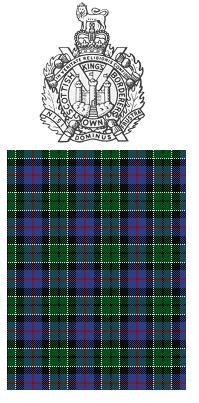
The King’s Own Scottish Borderers was a line infantry regiment of the British Army, part of the Scottish Division. On 28 March 2006 the regiment was amalgamated with the Royal Scots, the Royal Highland Fusiliers (Princess Margaret’s Own Glasgow and Ayrshire Regiment), the Black Watch (Royal Highland Regiment), the Highlanders (Seaforth, Gordons and Camerons) and the Argyll and Sutherland Highlanders to form the Royal Regiment of Scotland, becoming the 1st Battalion of the new regiment.
History Early history
David Melville, 3rd Earl of Leven, founder of the regiment
Plaque commemorating the raising of Leven’s regiment on Edinburgh Castle Esplanade
The regiment was raised on 18 March 1689 by David Melville, 3rd Earl of Leven to defend Edinburgh against the Jacobite forces of James II. It’s claimed that 800 men were recruited within the space of two hours. The regiment’s first action was at the Battle of Killiecrankie on 27 July 1689. Although this battle was a defeat for the Williamite army, the Jacobite commander, John Graham, 1st Viscount Dundee (Bonnie Dundee), was killed by a volley fired by Leven’s Regiment, bringing an end to James II’s attempt to save his throne in Scotland. The regiment was judged to have performed well and was granted the privilege of recruiting by beat of drum in the City of Edinburgh without prior permission of the provost.
Soldier of 25th regiment, 1742
For a period it was known as Semphill’s Regiment of Foot, the name under which it fought at the Battle of Fontenoy in 1745 and the Battle of Culloden in 1746. When the British infantry were allocated numerical positions in the ‘line’ of Infantry the regiment was numbered 25th Regiment of Foot (based on its formation date) in 1751. The regiment fought at the Battle of Minden on 1 August 1759 with five other regiments; this battle honour was celebrated by the regiment each year on 1 August. The 25th was the county regiment of Sussex in 1782 when it became known as the 25th (Sussex) Regiment of Foot.
The regiment was awarded the right to bear the emblem of the Sphinx for their role in the Battle of Alexandria in 1801. Its recruiting area was moved to the Scottish Borders region in 1805 from when the regiment became known as the 25th (the King’s Own Borderers) Regiment of Foot
Victorian era
The regiment was not fundamentally affected by the Cardwell Reforms of the 1870s, which gave it a depot at Fulford Barracks in York from 1873, or by the Childers reforms of 1881 – as it already possessed two battalions, there was no need for it to amalgamate with another regiment.[3] The regiment moved to Berwick Barracks in July 1881. Under the reforms the regiment became The King’s Own Borderers on 1 July 1881.[4] A 3rd, Militia, Battalion was formed as the Scottish Borderers Militia, with headquarters at Dumfries. The regiment became The King’s Own Scottish Borderers in 1887.
During the Second Anglo-Afghan War in 1878 to 1880, the regiment formed part of the 2nd division which was renamed the Khyber Line Force while guarding the lines of communication between Kabul and Peshawar.[5] It was embodied in January 1900 for service in the Second Boer War, and embarked for South Africa two months later. Most of the battalion returned home in June 1902.
In 1908, the Volunteers and Militia were reorganised nationally, with the former becoming the Territorial Force and the latter the Special Reserve; the regiment now had one Reserve and two Territorial battalions.
Sir Yes Sir Military Insignia provides most British Regiments Bespoke Rings, Cuff Links and Dog Tags. Furthermore, if we don’t have what you are looking for please visit out Custom Ring page and have us design exactly to your requirements

